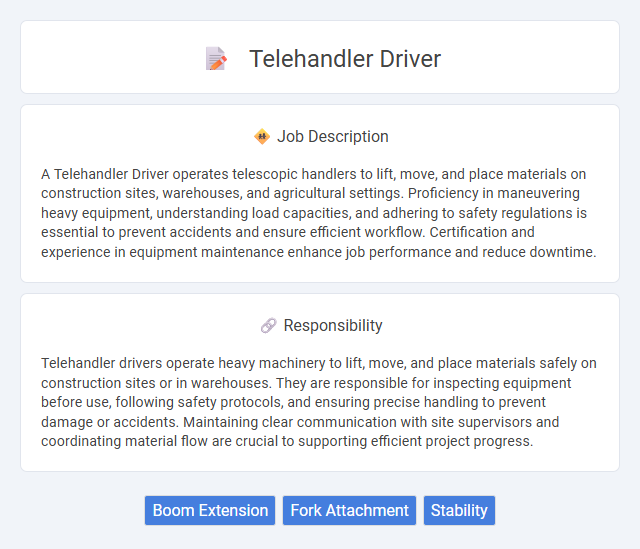
A Telehandler Driver operates telescopic handlers to lift, move, and place materials on construction sites, warehouses, and agricultural settings. Proficiency in maneuvering heavy equipment, understanding load capacities, and adhering to safety regulations is essential to prevent accidents and ensure efficient workflow. Certification and experience in equipment maintenance enhance job performance and reduce downtime.
Individuals with good physical health and strong coordination skills are likely suitable for a telehandler driver role, as the job often requires operating heavy machinery in potentially challenging environments. Those who prefer routine tasks and have a careful, safety-conscious mindset may find this position well-suited to their abilities. People struggling with mobility issues or difficulty maintaining focus might have less probability of thriving in this role due to its physical and attention demands.
Qualification
A qualified telehandler driver must possess a valid telehandler certification and demonstrate proficiency in operating various models safely and efficiently. Strong knowledge of load handling, safety protocols, and site regulations is essential to minimize risks and ensure smooth material movement. Experience in construction, agriculture, or warehousing environments enhances a candidate's ability to perform precise and reliable telehandler operations.
Responsibility
Telehandler drivers operate heavy machinery to lift, move, and place materials safely on construction sites or in warehouses. They are responsible for inspecting equipment before use, following safety protocols, and ensuring precise handling to prevent damage or accidents. Maintaining clear communication with site supervisors and coordinating material flow are crucial to supporting efficient project progress.
Benefit
Telehandler drivers likely gain significant benefits such as improved job stability due to high demand in construction and agriculture sectors. They probably experience enhanced earning potential compared to general labor roles, reflecting their specialized skills. Access to on-the-job training and career advancement opportunities may also increase long-term career prospects for telehandler operators.
Challenge
A telehandler driver job likely involves operating complex machinery that demands precision and constant attention to safety protocols, presenting a significant challenge. Navigating tight spaces and lifting heavy loads at various heights may test an operator's skill and adaptability. The role probably requires quick problem-solving abilities to manage unexpected obstacles and maintain efficient workflow on dynamic job sites.
Career Advancement
Telehandler drivers gain expertise in operating versatile lifting machinery essential in construction, agriculture, and warehousing, enhancing their value in evolving industrial sectors. Mastery of telehandler controls and safety protocols paves the way for promotion to supervisory positions or specialized operator roles involving complex equipment. Ongoing certifications and experience can lead to career growth opportunities such as site manager, logistics coordinator, or heavy machinery trainer.
Key Terms
Boom Extension
Operating a telehandler requires expertise in boom extension to safely and efficiently reach elevated or distant loads on construction sites. Precision in controlling the boom extension enhances material handling capabilities and optimizes workflow while maintaining site safety standards. Proficiency in boom extension ensures accurate placement of heavy materials, minimizing damage and improving overall productivity.
Fork Attachment
Telehandler drivers skilled in operating the fork attachment efficiently manage lifting, loading, and transporting heavy materials on construction sites and warehouses. Precision in maneuvering the fork attachment enhances safety and productivity while handling pallets or bulky items. Mastery of fork attachment controls is essential for optimizing load stability and minimizing damage during material handling tasks.
Stability
Telehandler drivers must prioritize stability to ensure safe lifting and maneuvering of heavy loads across construction sites or warehouses. Proper load balancing, precise control, and adherence to manufacturer weight limits prevent tipping and accidents. Mastery in assessing ground conditions and stabilizer deployment is essential for maintaining operational safety and efficiency.
 kuljobs.com
kuljobs.com